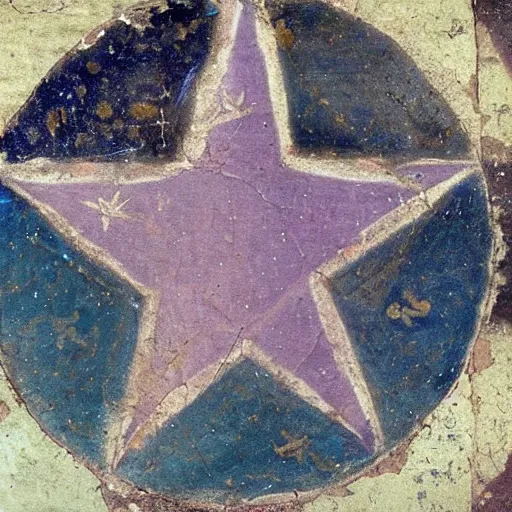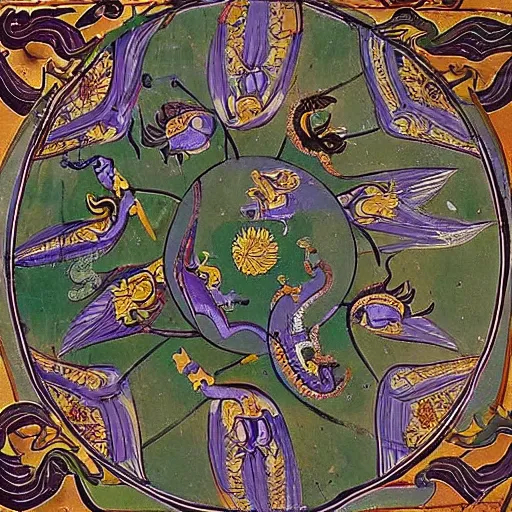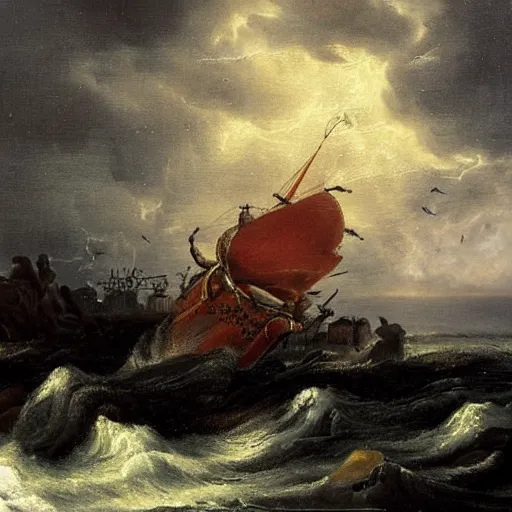Magic in Evera
In Evera, magic originates from divine energies. The still lingering power of the fallen, ancient dragon deity, the might of the Dragon Goddess and the energies of the deities working in the world - especially after their battles - are capable of creating extraordinary effects.
In the land of Evera, there are two ways of creating magic, Spells and Magic circles. Both have their advantages and disadvantages and few can master both.
Some Spells can be created only with spoken words - in exceptional cases with thoughts. The Spell can be said in any language, but a very precise translation is required to achieve the desired result. Because of this, most Spells were spread in the Sheyarin language, as they were created by Dragons. Of course, Spells created by other species were first spoken in other languages, and occasionally serviceable translated collections appear among the books sold.
Creating an effect with a Spell is not an easy task: you have to concentrate the magical forces present in the environment (or individual) and say the right words exactly. "Silent magic" requires exceptionally serious concentration, as a single disturbing thought can ruin the Spell.
The most simple Spells require only a single word, making them harder to mess up. Spells that create light, darkness, or drowsiness, as well as Spells of Power magic that convey many instructions, are not a problem even for beginners. To achieve more complex effects, longer, even full-page Spells may be required! Learning these is no small task for the residents of Evera.
The expression of magic, the creation of spells
In the land of Evera, there are two ways of creating magic, Spells and Magic circles. Both have their advantages and disadvantages and few can master both.
Spells:
Some Spells can be created only with spoken words - in exceptional cases with thoughts. The Spell can be said in any language, but a very precise translation is required to achieve the desired result. Because of this, most Spells were spread in the Sheyarin language, as they were created by Dragons. Of course, Spells created by other species were first spoken in other languages, and occasionally serviceable translated collections appear among the books sold.
Creating an effect with a Spell is not an easy task: you have to concentrate the magical forces present in the environment (or individual) and say the right words exactly. "Silent magic" requires exceptionally serious concentration, as a single disturbing thought can ruin the Spell.
The most simple Spells require only a single word, making them harder to mess up. Spells that create light, darkness, or drowsiness, as well as Spells of Power magic that convey many instructions, are not a problem even for beginners. To achieve more complex effects, longer, even full-page Spells may be required! Learning these is no small task for the residents of Evera.
Magic Circles:
Most Magic circles are related to some kind of Neutral magic, but there are also circles related to Elemental and Fairy magic (or of a completely different nature). The simplest Magic circles are the practical magic used in everyday life, which are common in most Dwarven, Giant or Elven households.
Around the drawn - or scratched, engraved - circle, Sheyarin runes are written in the appropriate order and arrangement. Runes trigger complex spells and concentration, all that is required is the magical energies to create the effect. With Magic circles, it is extremely important that the basic circle itself is complete. The easiest way to break the existing effect created by a circle is to "open it", that is, to break the continuity of the circle.
Magic circles can be found in public spaces, residential buildings, churches and also on so-called spell scrolls. These spells usually contain one rune less than necessary, and those called to "start" them know the finishing character to create the desired effect. While carved circles usually survive many activations, drawn, painted circles are usually destroyed after activation.
Most Summoning Spells can be created more stably using Magic circles than Spells alone.
There are also complex Magic circles consisting of several smaller circles, but more people are needed to activate them. They usually consist of three or nine smaller circles, but there are also descriptions of twenty-one circles of powerful magic.
Around the drawn - or scratched, engraved - circle, Sheyarin runes are written in the appropriate order and arrangement. Runes trigger complex spells and concentration, all that is required is the magical energies to create the effect. With Magic circles, it is extremely important that the basic circle itself is complete. The easiest way to break the existing effect created by a circle is to "open it", that is, to break the continuity of the circle.
Magic circles can be found in public spaces, residential buildings, churches and also on so-called spell scrolls. These spells usually contain one rune less than necessary, and those called to "start" them know the finishing character to create the desired effect. While carved circles usually survive many activations, drawn, painted circles are usually destroyed after activation.
Most Summoning Spells can be created more stably using Magic circles than Spells alone.
There are also complex Magic circles consisting of several smaller circles, but more people are needed to activate them. They usually consist of three or nine smaller circles, but there are also descriptions of twenty-one circles of powerful magic.
The moment before the disaster by A.I. (Stable Diffusion 1.5)
"The Last Moment Before the Catastrophe" is a painting by Yvon Linny in the Gallery of Eaglekeep. The image shows the explorer ship Narwhal before it sinks off the coast of Pedite. There are many legends and stories about the ship and its captain - the explorer Tomkin R. Vetelus - among the people of Lifeon."
Loose, miscast, and other incorrectly created spells
The effect of a botched Spell depends on the amount of energy focused on and the type of Spell it was created.
Spells are usually divided into five levels in terms of energy. On the first level, momentary, local effects can be created, e.g. to light a candle or campfire by blowing a spark. At the second level, the result will have a greater range or power, and at the third level, we can achieve a relatively long-lasting effect, like summoning a reading light. Third-level Spells created with verbs require serious concentration, residents of Evera who are not skilled in the use of magic cannot cope with it. Fourth-level Spells have a major influence on the environment, e.g. summons a creature from another plane or creates a huge storm and blizzard in the countryside. Fourth-level Spells are the specialty of master wizards with serious knowledge. The fifth level, on the other hand, affects Evera's physical and spiritual world to an almost divine degree, or it can affect more than one plane. Among the Elemental magics, supporting huge hurricanes and terrible earthquakes can be classified here, and among the Natural magics, creating a forest from a wasteland - with seeds - is considered such a powerful magic. At this level, Fairy magic can bring a dead person back to life, and Power magic can bring a city - or even a nation - to its knees. If the Spell is spoken incorrectly and is too similar to another Spell, it is quite possible that the other Spell will be cast. Beginners often fall into this mistake. (There are "false charms", which appear to be Charms, but in fact do not produce any effect.) If the Charm is interrupted for some reason - the person said the wrong words or lost concentration - the collected energy necessary to create the effect is released and is proportional to its amount can cause damage. It can change and deform the creator's appearance and physical integrity, the elements can break free and rage, posing a danger to everyone present. First-level, unsuccessful Spells usually "signal" back to the creator with a slight unpleasant sting or discharge, second-level Spells can even temporarily paralyze or knock the clumsy spell-user off their feet. Any magic stronger than that has the potential to be a disaster, so it must be handled with great care.
If the circle of the Magic circle is not complete, the effect will definitely not occur. If the symbols are drawn in the wrong order, it's pretty much the same as saying the Spell wrong - maybe nothing happens, maybe a different effect is produced. If the effect is created and the Magic circle is "opened", the effect is released from the control of its creator. With low-level magic, it usually dissipates, while from third level up, it can even turn against its creator, but it will almost certainly cause damage to its surroundings. A rain supported by a Magic circle can, for example, become a huge storm when released.
Spells are usually divided into five levels in terms of energy. On the first level, momentary, local effects can be created, e.g. to light a candle or campfire by blowing a spark. At the second level, the result will have a greater range or power, and at the third level, we can achieve a relatively long-lasting effect, like summoning a reading light. Third-level Spells created with verbs require serious concentration, residents of Evera who are not skilled in the use of magic cannot cope with it. Fourth-level Spells have a major influence on the environment, e.g. summons a creature from another plane or creates a huge storm and blizzard in the countryside. Fourth-level Spells are the specialty of master wizards with serious knowledge. The fifth level, on the other hand, affects Evera's physical and spiritual world to an almost divine degree, or it can affect more than one plane. Among the Elemental magics, supporting huge hurricanes and terrible earthquakes can be classified here, and among the Natural magics, creating a forest from a wasteland - with seeds - is considered such a powerful magic. At this level, Fairy magic can bring a dead person back to life, and Power magic can bring a city - or even a nation - to its knees. If the Spell is spoken incorrectly and is too similar to another Spell, it is quite possible that the other Spell will be cast. Beginners often fall into this mistake. (There are "false charms", which appear to be Charms, but in fact do not produce any effect.) If the Charm is interrupted for some reason - the person said the wrong words or lost concentration - the collected energy necessary to create the effect is released and is proportional to its amount can cause damage. It can change and deform the creator's appearance and physical integrity, the elements can break free and rage, posing a danger to everyone present. First-level, unsuccessful Spells usually "signal" back to the creator with a slight unpleasant sting or discharge, second-level Spells can even temporarily paralyze or knock the clumsy spell-user off their feet. Any magic stronger than that has the potential to be a disaster, so it must be handled with great care.
If the circle of the Magic circle is not complete, the effect will definitely not occur. If the symbols are drawn in the wrong order, it's pretty much the same as saying the Spell wrong - maybe nothing happens, maybe a different effect is produced. If the effect is created and the Magic circle is "opened", the effect is released from the control of its creator. With low-level magic, it usually dissipates, while from third level up, it can even turn against its creator, but it will almost certainly cause damage to its surroundings. A rain supported by a Magic circle can, for example, become a huge storm when released.

Magic by A.I. (Stable Diffusion 1.5)
"Magic": a mural on the wall of an Undine wizarding school. The five-pointed star is the symbol of Evera's magic and the power of the gods.
The Five Type of Magic
Magic in Evera is classified into five different types. These are Neutral, Elemental, Nature, Power, and Fairy magic.
- Neutral Magic: Any spell that doesn't fall into the other four groups. It occasionally uses an element, but does not call upon spirits. It can affect plants, animals, or a mind, but not with the effective force as Nature or Power magic.
- Elemental Magic: In Evera's world, the Elements are practically spirits, called to life by the Dragon Goddess at the beginning of time. They are even older than the gods. (Each elemental force has its own spirit.*)
- The magic of Nature: Originally a collective name for Spells suitable for influencing the growth and behavior of plants and animals. There is a known group of Natural magic that is also Elemental magic: spells that affect the weather are included in both types of magic.
- The magic of Power: A range of Spells capable of influencing time, space and mind. It gets its name from the fact that it is often used for evil purposes. Power-type magic is also all forms of divination and teleportation. It is partially intertwined with Natural magic, as some of the Spells that affect the mind are also suitable for influencing animals.
- Fairy magic: Originally used by the fairies created by Narmiraen, it contains protective and healing Spells. It sometimes overlaps with Elemental magic: Fairy magic can manipulate fire and water without calling on the associated spirits.

Ritual by A.I. (Stable Diffusion 1.5)
"Ritual": a fresco on the ceiling of an ancient dragon temple in the archipelago of southern Xornu. The dragon figures in the painting are probably performing a mystical ceremony. According to Evera tradition, purple is the color of magic and gold is the color of the Dragon Goddess. Dragon art is characterized by depiction from an overhead perspective, as flying is part of their everyday life.





Megjegyzések